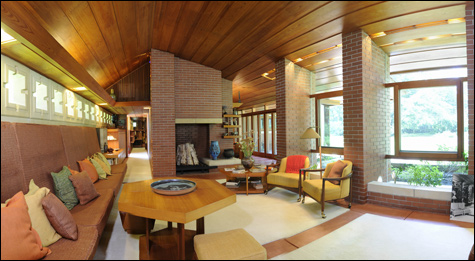
COZY FOR TWO Frank Lloyd Wright’s Zimmerman House strives for an open feel in a limited space. |
Charles and Henry Greene came to Boston in 1888 to study architecture at Massachusetts Institute of Technology. The school was then in the Back Bay, and the brothers rented rooms nearby, close to Henry Hobson Richardson's landmark Arts and Crafts–style Trinity Church and the original Museum of Fine Arts, with its budding collection of Japanese art.
A couple of years after graduation, Charles lost his Boston job in a financial crisis, and they moved West. In 1894, in Pasadena, they launched their architectural firm Greene & Greene. The Museum of Fine Arts' splendid exhibit "New and Native Beauty: The Art and Craft of Greene & Greene" (through October 18) shows how they pioneered a West Coast design built on the inspirations they brought with them: the elegant minimalism of Asian design and the Arts and Crafts Movement's emphasis on handcraft and a what-you-see-is-what-you-get "honest" use of materials.
The Greenes may be unfamiliar hereabouts because most of the some 140 homes they designed were in Southern California. Charles is often described as the lead designer, the artist and dreamer; Henry filled the role of the practical guy who makes sure things get done. Their buildings blend elements of English cottages, Mexican haciendas, grand hunting lodges, and Japanese temples with their broad overhanging roofs. The Asian influence is particularly pronounced in their interiors — hanging lanterns, metal strapping, exposed beams with curved ends.
This exhibit, which was organized by the Gamble House of the University of Southern California and the Huntington Library in San Marino, focuses of necessity on more portable stained glass, metal work, furnishings, and interior decoration. The earliest known example of Greene furniture is a wooden breakfast table that Charles designed for his fiancée, Alice White, in 1899. It has a heavy square top supported by a single stout pedestal, like something from a mediæval European hall. Its craft is expressed solely in the contrasting colors and grains of the planking, which is laid out in a quilt-like pattern.
Asian influences appear in a 1908-'09 mahogany and ebony dining-room table for the Blacker House. The wide, thin, rectangular top seems to float lightly on thin legs. Its only adornments are the strips of wood at each end and the tiny abalone inlay flowers at the corners; the craft is in the way it's all joined together.
A 1912 mahogany and ebony living-room table for the Pratt House in Ojai, California, recalls Charles's 1899 table in its use of contrasting pieces of wood for decoration. But the spare, light design reflects Asian influences, right down to the simple wavy line decoration on the Chinese-inspired drawer handle.
The Greenes' work prompts thoughts of Frank Lloyd Wright, and indeed the curators have included one of Wright's iconic 1900 tall-back chairs. Compare it to Greene & Greene's 1907 hall chair, which seems to take the square seat of Wright's chair and pinch it so that it becomes narrower at the back than at the front. The spindles of the matching tall narrow back angle in. Wright adheres to a rigid geometry of rectangles, straight lines, and perpendiculars; the Greenes favor more angles and curves. Experts say the Greenes' furniture is correspondingly more comfortable.